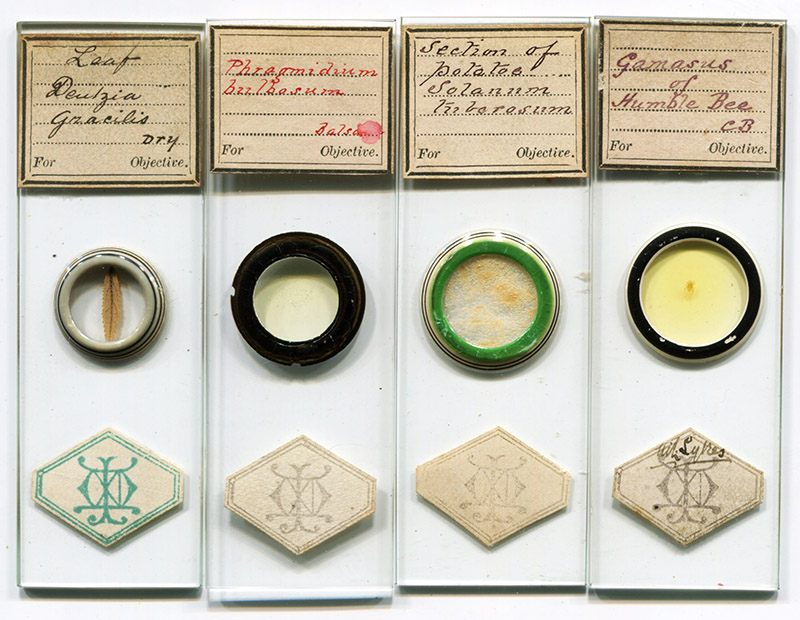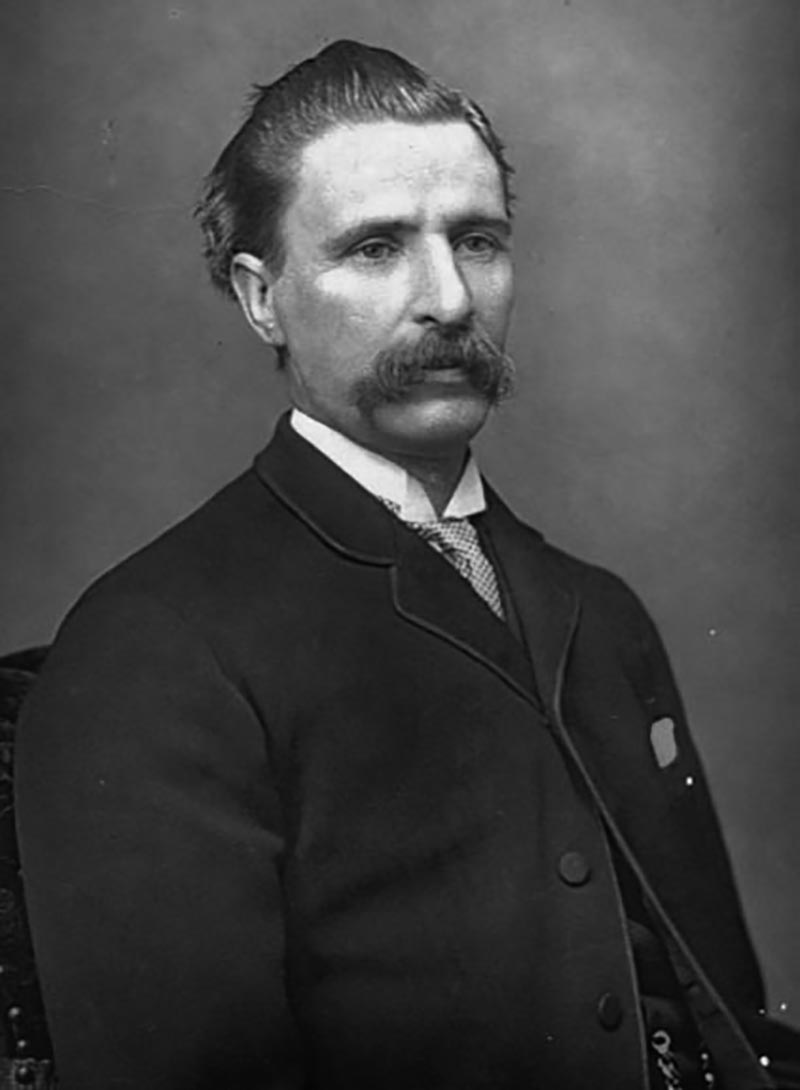
Figure 1. Microscope slides that were made by J.L.W. Miles, all bearing his complex monogram. The slide on the right was once owned by Miles’ colleague Mark L. Sykes, whose signature is on the label.
John Lenton Ward Miles, 1845 - 1916
by Brian Stevenson
last updated September, 2017
Eyes are immediately drawn to the large, complex monogram labels that Miles placed on his microscope slides (Figure 1). Looking beyond that, Miles’ slides are skillfully-made and neatly finished. He was a long-time officer of the Manchester Microscopical Society’s Mounting Section, taught classes to other members, and published several articles on slide-making techniques.

Figure 1.
Microscope slides that were made by J.L.W. Miles, all bearing his complex monogram. The slide on the right was once owned by Miles’ colleague Mark L. Sykes, whose signature is on the label.

Figure 2.
John L.W. Miles. Adapted for educational, nonprofit purposes from http://www.manchestermicroscopical.org.uk/miles.jpg
John appears to have been the only child of William and Elizabeth Miles. His birth record has not been identified, but census and his death record point a birthdate in 1845. His father was a stationery seller. He and the family moved with some frequency: William was born in Bath, Somerset; he somehow met Elizabeth, who was from Hull, Yorkshire; John was born in Manchester; the 1851 census listed them as living in Liverpool; and the 1861 census had Elizabeth and John in Salford, with father William away from home.
The 1861 census listed that the 16 year-old John worked as an “assistant pawnbroker”.
John married Elizabeth Broughton in 1867. The couple had three children, two girls, then a boy. Around this time Miles took work as a “water rate inspector's assistant” for the Manchester municipality, and remained a water bill collector for the city through most of his life.
Miles was an active amateur microscopist by the time he was in his thirties, and became one of the founding members of the Manchester Microscopical Society, in 1880. He later spoke of those days:
“Twenty-seven years ago, I made the acquaintance of the late Mr. Edward Ward, Microscopist (for some time one of our Vice Presidents), who at that time occupied premises in Burlington Street, and from him I purchased my first microscope and acquired a knowledge of microscopical work. In looking back, I cannot help but express my surprise at the energy and perseverance I then displayed in overcoming all the initial difficulties which I encountered. I was not long, however, in finding out how disappointing and disadvantageous it was to lack the acquaintance and companionship of others similarly occupied, and it naturally occurred to me that if only a dozen amateur microscopists could be found in the neighbourhood of Manchester willing to combine for mutual help and intercourse, a club or society could be formed on lines beneficial to every member. After several conversations with Mr. Ward, who offered to assist me as far as he could, I wrote a letter (in the autumn of 1879) which was published in the ‘City News’, advocating the formation of a society for the furtherance of microscopical study. In the correspondence which followed, my idea was somewhat deprecated. I was urged to join the Lower Mosley Street Natural History Society, or become a member of what, if I remember rightly, was called the Manchester Science Association, both of which were stated to utilise the microscope in scientific work. However. I was also the recipient of letters offering support and encouragement, and in the month of November, 1879, I wrote to about fifteen gentlemen stating my intention to call a meeting. This letter caused me to make the acquaintance of Mr. R. Bastow (afterwards the Society's first Secretary), who joined with me in calling a meeting and helping in the formation of the Society. This meeting was held on the 18th of December, 1879, at the old Mechanics' Institution, Princess Street, and was attended by some twenty-seven gentlemen. Dr. John Tatham was in the chair, and after some little deliberation the Society then and there started on its career. Thirty-three names were enrolled, Dr. Tatham was elected President, and a Provisional Committee was appointed (of which I was one) to draw up rules, &c. Amongst those who attended this meeting were several well known names, viz. : Messrs. E. Ward, Rd. Bastow, R. Graham, Thos. Brittain, W. Chaffers, T.W. Lofthouse, E.P. Quinn, W.W. Dawson and J.H. Furnival; all of whom afterwards did their utmost to make the Society a success.
The Mounting Section - at first called the Mounting Class - was the outcome of a discussion on mounting at a meeting of the Society, held on the 24th of June, 1880, when I proposed the formation of a class. The idea was at once taken up, twenty members handing in their names to start with. It is needless to say that as a class or section, it at once became popular and successful”.
An 1882 account of a meeting of the Mounting Section emphasized Miles’ slide-making skills, “The opening meeting of the session of the Manchester Society was held on Wednesday evening, the 11th inst., Mr. J.L.W. Miles in the chair. It was extremely well attended, rendering necessary the formation of a junior and a senior division, and showed that the value of practical exposition is becoming more and more appreciated by the general members of the Society. As illustrating the scope of this section, the junior members, as in previous sessions, will proceed with cell making for dry and fluid mounts; mounting in balsam and glycerine jelly, ringing and finishing off; while the senior members are promised among others, demonstrations by the following gentlemen: Preparation and section cutting of vegetable tissues, Mr. R.L. Mestayer; Animal tissues and mounting of insects in pure balsam, without pressure, Mr. H.C. Chadwick, F.R.M.S.; Extraction of palates and insect dissections, Mr. W. Chaffers; Dissection of the oyster, Mr. E.P. Quin; Fluid mounts, Mr. J.L.W. Miles; The use of the Microtome, Mr. A. Hay; Double staining, Mr. A.J. Doherty, and Microcrystallization, Mr. E. Ward, F.R.M.S., Mr. W. Stanley, in the junior division, proceeded to illustrate by means of brown cement and brass rings, the first processes of cell making for dry and fluid mounts. In the senior division the demonstrator was Mr. J.L.W. Miles, who cut sections of the potatoe for mounting as a dry and opaque object, emptying a portion of the cells of their starch contents, and thus exhibiting clearly the cell structure; the remaining cells showing the starch in situ. Of the many methods of mounting sections of the potatoe, this is perhaps the most satisfactory, whether we regard it as an object of interest and beauty, or as a slide for botanical instruction, Mr. Miles also mounted starch in balsam for the Polariscope”.
Miles remained active in the MMS throughout his life. He served as President in 1886, Vice-President in 1887, and Executive Committee member for several years. Miles was also a Fellow of the Royal Microscopical Society.
J.L.W. Miles was still working as a water bill collector in 1912. He died on September 23, 1916, at the age of 71, and the probate of his will listed him as then being retired. Curiously, one “Nellie Clarson, spinster” was executrix of his estate, rather than his wife, daughters, or son.
Acknowledgements
My thanks to Steve Gill for deciphering J.L.W. Miles’ monogram, and for generously sharing information on his life.
Resources
England census, birth, and other records, accessed through ancestry.com
Manchester Microscopical Society web pages (accessed September, 2017), http://www.manchestermicroscopical.org.uk
Miles, J.L.W. (1886) The capturing, killing, and preservation of insects for microscopical purposes, Transactions and Annual Report of the Manchester Microscopical Society, pages 80-81
Miles, J.L.W. (1905) The inception and formation of the Manchester Microscopical Society, Transactions and Annual Report of the Manchester Microscopical Society, pages 39-40
The Northern Microscopist and Microscopical News (1882) Minutes of the December 21, 1881, meeting of the Manchester Microscopical Society, “Mr. J.L.W. Miles called attention to a simple substitute for the parabaloid or spot-lens, for obtaining dark-field illumination, by using the bull's-eye condenser under the stage of the microscope, the plane side being turned up, with a spot of black paper in the centre. Tube fittings under the stage of microscopes should be removed in order to get the condenser sufficiently close to the stage. Another useful contrivance in place of a revolving table was, in its simplest form, a piece of table oilcloth about fifteen inches square, the cloth side turned to polished tables and the oil side to painted tables. This would carry an instrument and lamp round ordinary tables very smoothly”, Vol. 2, page 39
The Northern Microscopist and Microscopical News (1882) Minutes of the November 11, 1882, meeting of the Manchester Microscopical Society’s Microscopical Mounting Class, Vol. 2, page 322
The Official Handbook of Manchester and Salford (1912-1913) “Collectors of Water Rates and Rentals … J.L.W. Miles”
Probate of the will of J.L.W. Miles (1916) “Miles, John Lenton Ward, of 108 Southbank Road, Southport, Lancashire, retired Corporation Official, died 23rd September 1916. Probate Liverpool 25th October 1916 to Nellie Clarson, spinster. Effects £811 13s. 6d.”, accessed through ancestry.com